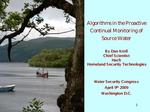Description
In addition to water recycling and reclamation programs, indirect potable reuse ofwastewater has occurred over the past few decades, which will likely increase in the future asupstream wastewater treatment plants (WWTPs) discharge water into rivers or lakes that serve asdownstream drinking water supplies. Attention has focused on pharmaceuticals and endocrine disruptors, butWWTPs are also sources of disinfection byproducts (DBPs), if chlorine disinfection ispracticed, and DBP precursors.Biological wastewater treatment takes one of two general forms: suspended growth(biofloc) systems (e.g., activated sludge); and, attached growth (biofilm) systems (e.g., tricklingfilter). Depending on operational conditions, both can operate as partial or completenitrifying processes. Increased levels of nitrification decrease the concentrations of ammoniaand organic nitrogen (amino) compounds. Nitrification transforms ammonia and organicnitrogen to nitrate. Suspended growth systems under anoxic conditions can denitrify (convertnitrate primarily to nitrogen gas).Treated wastewater has been shown to be a source of precursors for a wide range ofDBPs (trihalomethanes [THMs], haloacetic acids [HAAs], haloacetonitriles [HANs], andnitrosamines). The objective of this study was to evaluate the contribution of treatedwastewater to DBP formation in drinking water supplies, including an examination of seasonalimpacts. Methods included a survey of approximately 20 WWTPs in the U.S. that used a range of treatment processes (oxidation ditch, aerated lagoon, tricklingfilters, activated sludge, nitrification/denitrification, soil aquifer treatment, membranes, orvarious combinations). For most of the study sites, samples were collected at the WWTPs anddownstream DWTPs, effluent-impacted rivers or monitoring wells.Samples were collected during a wet/cold season and a dry/warm season in 2004, andonce more in a second year (2005). The two sampling events in year 1 were based on hydrologyand treatment considerations. These two seasons showed the different impacts of hydrology andtreatment. In year 2, many of the utilities were re-sampled in the season that provided especiallyinformative data for that system to ascertain temporal (year-to-year) variations. The samples were analyzed for ammonia, dissolved organic carbon (DOC), dissolvedorganic nitrogen (DON), and DBP precursors. Selected WWTP samples were analyzed for totalKjeldahl nitrogen (TKN), which consists of organic nitrogen in a -3 oxidation state (i.e., aminonitrogen) and ammonia. DBP precursors were measured using formation potential (FP) tests.The anti-convulsant pharmaceutical primidone was measured, as it is a conservative tracer(indicator) of wastewater influences in drinking water supplies. Includes 4 references, tables, figures.
Product Details
- Edition:
- Vol. – No.
- Published:
- 06/01/2006
- Number of Pages:
- 17
- File Size:
- 1 file , 390 KB
- Note:
- This product is unavailable in Ukraine, Russia, Belarus





